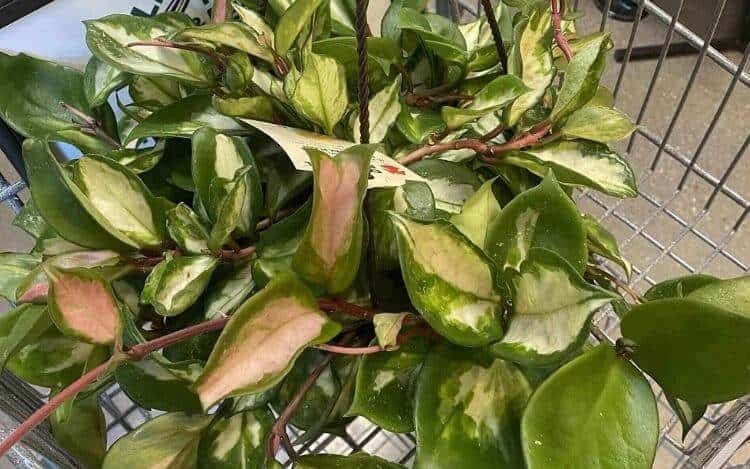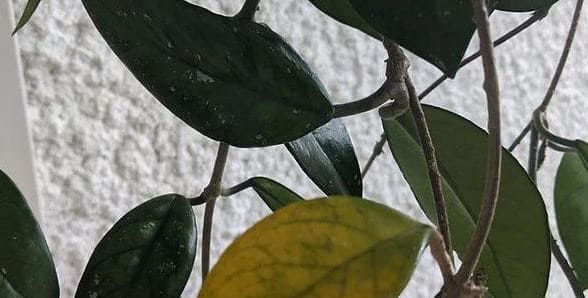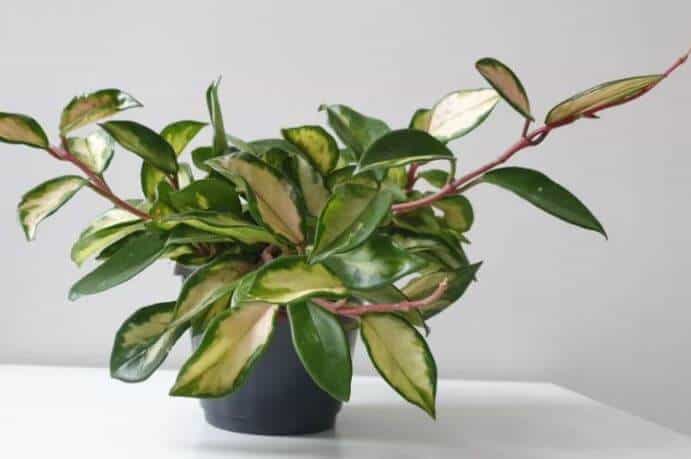Last Updated on February 1, 2023 by a Friendly Gardener
If a Hoya plant develops yellow foliage, the alarm bells should go off! Your plant is communicating that it has a problem and needs help. A native of the tropics and subtropics in Oceania and Asia. Commonly referred to as a “Wax plant”, Hoya species are characterized by thick green foliage that appears waxy and is part of the allure of owning one. These plants enjoy long lifespans and offer impressive growth and will produce clusters of fragrant blossoms in optimal environmental conditions.
So, when leaves begin to yellow you know that your plant is distressed. There are a variety of reasons that a Hoya plant can begin yellowing including overwatering, insufficient drainage, lighting problems, disease, and climate problems. Whatever the reason, you need to intervene. If you can identify the root of the problem, you can fix it.
Why Are My Hoya Leaves Turning Yellow?

Among the most common reasons for a Hoya plant to develop yellowing leaves, we find
- Overwatering
- Underwatering
- Improper Lighting
- Improper environmental temperatures
- Incorrect growing medium or soil
- A Lack of Nutrients
- Pest infestations
- Diseases
- Acclimatization
- Normal Aging
Overwatering
Overwatering is probably the number one cause of yellowing leaves not only on Hoya plants but on houseplants in general. Excess water in the soil bed impedes proper and necessary aeration of the soil. A plant needs oxygen just like we do, and their root systems require oxygen for them to be able to nourish themselves correctly. With too much water, roots drown and suffocate. They no longer send nutrients to all parts of the plant, so they are no longer able to photosynthesize and nourish themselves. Leaves turn yellow, root rot sets in and your plant dies.
Make sure that your plant’s container has a good number of drainage holes and that you use well-draining potting soil as the growing medium. Limit your watering to when your plant’s topsoil is dry approximately two inches deep. Check drainage holes regularly for blockage and make amends if necessary.
Underwatering

Water is a primary need for the survival of vegetation. It enables the movement of nutrients from the root system throughout the entire plant. If your Hoya is underwatered, leaves will yellow, and your plant will begin to wilt. Although Hoyas have thick succulent-like foliage and will store moisture, they can only withstand brief periods without water. Eventually, they will succumb to a lack of it.
If the soil bed feels bone dry, underwatering may be the cause of your Hoya plant turning yellow. Water your plant thoroughly and allow excess water to drain.
Improper Lighting

Hoyas are plants that naturally grow amid trees and other vegetation, so they do not receive direct sunlight. Consequentially, they need bright indirect sunlight to thrive. Excess light can cause leaves to turn yellow and then brown. They may also pale from too much light.
If the light is too low, your plant’s leaves will initially turn very green in an attempt to collect enough light for nourishment. If low lighting continues, the plant will be unable to sustain its needs and its leaves will yellow.
Place your Hoya plant in a spot with ample bright, indirect light.
Improper Environmental Temperatures
Hoya plants are tropical species that prefer warmer climates as opposed to cold weather. Hoya plants that are cultivated indoors require environmental temperatures that measure between 65° and 80°F. Hoyas can manage temps as high as 90°F in hot seasons but no lower than 50°F. during winter or cooler weather.
When exposed to the cold or drafts, the foliage will yellow, shrivel, and drop off. Exceptionally high heat and a lack of humidity will also cause foliage to yellow. In hot weather, insufficient watering will exacerbate the problem.
Track your indoor temperatures and adjust when necessary. Avoid positioning Hoyas near air conditioning or heating units and vents as well as drafty windows.
Incorrect Soil
Consider that Hoya species will grow in tree crevices in their natural habitats. They are not soil dwellers. This indicates that the soil mix you select must offer excellent drainage and aeration for your plant to thrive. Improper soil blends may be the cause of soggy soil and excess water. Roots will begin to sicken and rot.
If you note that your soil mix remains excessively moist even a few days after you have watered, this may be your plant’s stressor. You should repot your plant with a fresh soil blend that is formulated for cacti or succulents in equal parts with orchid bark and perlite. You can also opt for a blend of two parts peat moss and one-part pumice. The key is in the drainage.
A Lack of Nutrients

All living things require nutrients to survive and thrive. When Hoya plants leaves turn yellow, they may be suffering from a lack of nitrogen, potassium, phosphorous, or magnesium. Nitrogen is crucial for photosynthesis and the production of chlorophyll which accounts for green-hued foliage. When nitrogen is lacking, leaves will turn yellow. One indication that a lack of nutrition is the culprit will be the condition of new leaves. They will appear wrinkled and pale.
Leaves that are already yellow will not recover, but you can protect new growth. Most soil blends will furnish enough nutrients for a couple of years. After two years you can repot with fresh soil or begin to fertilize.
Pest Infestations
Resistant to most pests, the Hoya can fall prey to some sapsuckers. Mealybugs and aphids are the more common insects that you may find on a Hoya houseplant, but occasionally thrips, scales, and spider mites can take up residency and be the cause of Hoya leaves yellowing.
Check your plant regularly for evidence of pest infestation. Wash off peats using insecticidal soap or a soapy dishwater solution. You can also treat your plant with Neem oil. If the plant is heavily infested and damaged, destroy it before pests spread to other vegetation.
Disease
Hoya species are relatively disease-resistant because the foliage texture tends to be waxy. If, however, the soil is allowed to remain soggy, root systems will be susceptible to fungal infections like root rot. Hoya plant leaves turning yellow generally indicate that the disease is at an advanced stage.
Remove the Hoya plant from the soil and check the root system. If roots are brown and mushy, all infected roots need to be trimmed off. Repot the plant in fresh soil. If you needed to trim a substantial part of the root system, consider pruning the plant to a size that the root system can support. For heavily diseased root systems, it is better to destroy the plant.
Acclimatization

When transporting a new Hoya plant home from your local garden center or when changing a plant’s position, there may be a problem with acclimating to a new environment. Leaves may be yellow and drop. Give your plant time. It will eventually acclimate to its new home.
Normal Aging
As plants age, they will shed older foliage to allow for new growth. Older leaves will turn yellow and eventually fall off the plant. This is a normal process and is not cause for alarm. If you have ruled out other causes, you can simply prune older leaves if you prefer not to wait for them to drop.


